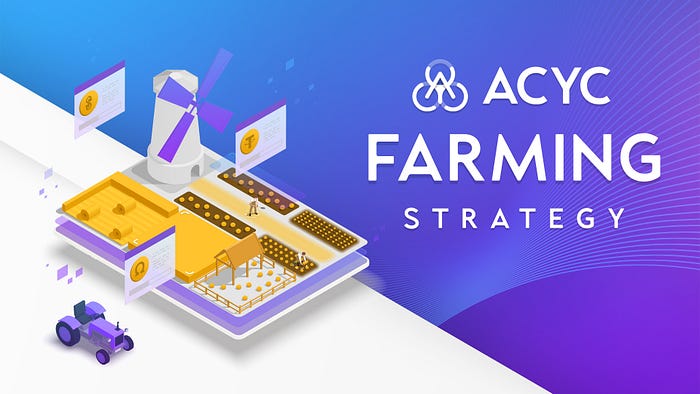
Hello $ACYC community, I am Uncle Pennybags — as many of you are aware, I’ve recently been brought onboard as a DeFi yield farmer for ACYC.
Just about 10 days ago (Dec 19, 2021), I was tasked to farm with 100 ETH focused primarily on a mix of low-medium risk farming. So far, this has been going quite well and below I’m going to provide an update on our current portfolio balance, what our farming strategy currently looks like, and what the reasoning behind each play is.
Portfolio from Dec 19, 2021 — Dec 27, 2021:
On Dec 19, 2021, we started with a 100 ETH balance worth approx. ~$3,950/ETH at that time ($395,000 USD)
This is what our current portfolio looks like today:
- 42.05 ETH locked as collateral under a ETH short call position with a strike price of $4K and expiry on Jan 7, 2021 on https://www.lyra.finance/
- At the current price of ~$4,090 ETH, the 42.05 ETH position is $90 in the money, so there’s a paper debt of $3,784.50 (~0.925 ETH)
- 42.05 ETH — 0.925 ETH of paper debt = 41.125 ETH net balance on Lyra
- 14,405.33 est. LYRA in farming rewards to be unlocked on Jan 7, 2021, which at the current market price of $0.31/LYRA equals $4,465.65 USD (~1.09 ETH)
- 16.21 ETH deposited and actively managed in the https://www.cap.finance/ ETH pool
- $63,531.05 USDC deposited and actively managed in the https://www.cap.finance/ USDC pool (~15.53 ETH)
- 3.3674 $YFI sitting as a wallet balance, which at current market price of $33,697 per YFI equates to $113,471.82 USD (~27.74 ETH)
- ~0.5 ETH sitting as a wallet balance
Current net balance as of today (Dec, 27, 2021): 102.195 ETH ($417,977.55 at $4,090/ETH)
We are up 2.195 ETH over a 10 day period in ETH terms, and $22,977.55 USD in fiat terms. This annualizes to a 79.02% APR in eth and 209.42% APR in fiat. Needless to say, the portfolio has been performing incredibly well for us over the last 10 day period, especially considering the fact that the majority of our 100 ETH portfolio consists of low-medium risk assets.
Farming Strategies
If you look at our portfolio balance above, you can see that I’ve deployed the 100 ETH across 3 primary farming strategies:
- Selling short call options on lyra.finance
- Actively managing the ETH and USDC pool on cap.finance
- Holding a $YFI position (we will leverage this position for farming later, but for now, we’ll simply be holding $YFI in the very near term)
Before I dive into why I made each of these calls, I’ll first explain my outlook on the crypto markets in the short term.
Penny’s Macro Outlook
Looking at the markets as a whole, I’ve been somewhat cautious on how the crypto markets have been moving. Since ETH dropped from the peaks of $4.8K down to $4K and then the rebound to $4.4K, it’s been moving in a very volatile manner and while we have a chance to continue climbing up from here, there’s also a good chance we can fall back to the low-mid $3K range.
For my personal portfolio, I had converted a decent % of my portfolio to stablecoins on the rebound at the $4.4K mark, and I have also shorted successfully down to the $3.7K range before going back long above $4K ETH. I applied the same macro outlook as I did with the $ACYC wallet, believing that the markets have a good chance of moving sideways or slightly downwards in the short-medium term. While there’s still a chance of the markets going back up from here, we’re doing low-medium risk farming and obviously, we play it better safe than sorry.
With the ACYC treasury wallet, I wanted to accomplish primarily two things:
- Despite the markets being volatile, I still wanted us to have decent exposure to $ETH and the crypto markets in some way or form
- I don’t know if the markets were going to go up or down from here (Dec 19, 2021), my gut feel was sideways or down movement. However, one thing I had strong conviction on was we were going to experience above average volatility, and I wanted to make a play where we win on volatility, whether the markets move up or down.
10 days later, it seems my gut feeling was correct. We experienced sideways and slightly downwards movement, and as a result, we enjoyed maximum upside on our primary farming strategies yielding a 79% annualized return on ETH, and an over 200% annualized return denominated in USD.
Breaking down our farming strategies
Now that you know how I feel about the overall markets and what my overall strategy was going to be (play on volatility and sideways/downwards movement), let’s break down each of the three farming strategies I had deployed:
Selling short calls on Lyra Finance
For anyone who’s been exposed to TradFi and stock investing, call and put options shouldn’t be anything new to you — options are essentially the right to buy or sell an asset at a specific price before a specific time.
In crypto, particularly DeFi, however, options trading is a very new concept, and Lyra Finance is essentially a DeFi protocol that aims to solve options trading in crypto.
They’re based on the Optimism network (a relatively new layer 2 network on Ethereum) and to start, I bridged 39.5 ETH over to Optimism specifically to sell short calls through Lyra. To do this, I needed to first sell the ETH into sUSD (synthetix USD), and buy back sETH (synthetix ETH) so I had to take a small hit in trading/spread fees before I could open the position. I had about ~39 sETH by the time I finished trading from ETH to sETH after counting for the related gas/trading fees.
On Lyra, I specifically wanted to sell call options for ETH. I opted for the $4,000 strike price with a Jan 7, 2021 expiry date (the longest expiry options available) as I believe ETH would either stay stagnant close to $4K, or tumble down to mid $3Ks by the end of the period.

The $4K call option back at that time was also attractively high compared to others, sitting at ~98% IV at the time I sold versus ~90% for the $3.7K and ~94% for the $4.4K options.
I sold these calls for approx ~$330 premium per ETH call after fees. This means that even if ETH went up to $4,330 and we had to sell our ETH to the person exercising the call option to buy our ETH for $4,000, we would still be breakeven on the trade. On the other hand, we have a cushion if ETH falls to $3,670, as we received $330 of premium per ETH. Our maximum upside is if ETH falls out of the money at $3,999 by Jan 7, 2021 and the options we sell expire without the person getting a chance to exercise it in the money.
Given my stance and caution on the overall market, I decided this was the best course of action with a good portion of the ETH as I wanted us to still have exposure to ETH and not get stuck with just stablecoins. At the very least, even if ETH were to suddenly moon in 3 weeks, we would still be selling ETH at an effective price of $4,330 per ETH rather than selling immediately at $3,900.
Actively managing the ETH and USDC pool on Cap Finance
Cap Finance is essentially a protocol on Arbitrum that enables traders to leverage trade in a decentralized manner.
They allow traders to trade ETH-USDC and BTC-USDC, and as a trader, you can trade up to a 50x leverage.
However, what happens when a trader makes money or loses money on leverage? This is where the Cap Finance pools come in. When a trader makes money, they take profits out of the ETH or USDC pool, and vice-versa, when they lose money, the money that’s lost gets dumped back into the pool. The trader is essentially the player and the ETH/USDC pools are the house.
I did say that I wanted to make a play on volatility right? When the markets are volatile, leveraged traders stand to lose the most so depositing funds into the ETH and USDC pool was a perfect play on volatility. Furthermore, all the funding rates and trading fees get deposited back into the pool so this is a positive EV investment on average.
In fact, I would say depositing into the ETH/USDC pools on Cap Finance is semi-shorting because most crypto traders are long. Typically, there are more traders who trade long on an exchange than there are shorters. When the markets suddenly move downwards, much more liquidations happen than when the markets suddenly move upwards.
And so I decided to deposit 14.9 ETH into the ETH pool and $59,061 USDC into the USDC pool. All profits generated were deposited right back into the pools and this is what the balances look like today:

In 10 days, we generated very generous returns on both the ETH and USDC pools because of the volatility we’ve seen with ETH moving between $3.7K — $4.1K.
But that’s not all, I mentioned that both pools were actively managed. Because Cap Finance trades are fully on chain, it’s possible to see open long-short positions and how much open profits there are in total.
For example, if there were a lot of long ETH positions and ETH suddenly spiked upwards, some traders may not close their positions immediately and there’s an open profit position. I monitor these positions actively and withdraw from the pool when the open profit position becomes too high.
This way, we minimize our losses when traders are winning, but maximize gains when traders lose.
Holding a $YFI position
This is not a farming strategy (yet), but I felt like we ought to hold a $YFI position going into 2022 and I strongly believe this will turn into a massive cash cow when the token reforms happen.
For those of you unaware, Yearn Finance is one of the fathers of DeFi who took the reins during DeFi summer last year. They’re a ‘blue chip’ DeFi token but have fallen substantially in the past year due to poor tokenomics and tie-in with the protocol. Like many other blue chip DeFi tokens such as Aave, Compound, etc, the protocols generate tremendous value but there’s no value accrual with their token, which is why a lot of these tokens have fallen drastically in value.
Move to late 2021 and banteg, one of the founders of Yearn started teasing on the tokenomics of $YFI and how $YFI tokenomics will change very soon.
This finally became a reality when Yearn proposal YIP-65 hit the forums: https://gov.yearn.finance/t/yip-65-evolving-yfi-tokenomics/11994
You can give this a read yourself if you’re interested but this is why I decided we ought to hold a long position on $YFI. What we can later do with this position is we can deposit this into a Yearn vault or Aave as collateral to borrow stables/ETH which we can then put back into a slightly higher risk higher return farm. This allows us to earn with borrowed capital, and also potentially double farming when xYFI is released and we additionally earn from staked YFI.
The tweets below also illustrate why go long $YFI with the evolving tokenomics pretty well too:
https://twitter.com/adamscochran/status/1471518544944943104?s=21
https://twitter.com/0x7d54/status/1471538824635367431?s=21
Anyhow, this concludes my update on our current farming progress! Going forward, I’ll also make sure to send continual updates when there are any material changes in our farming strategy and results. Thanks for reading.

